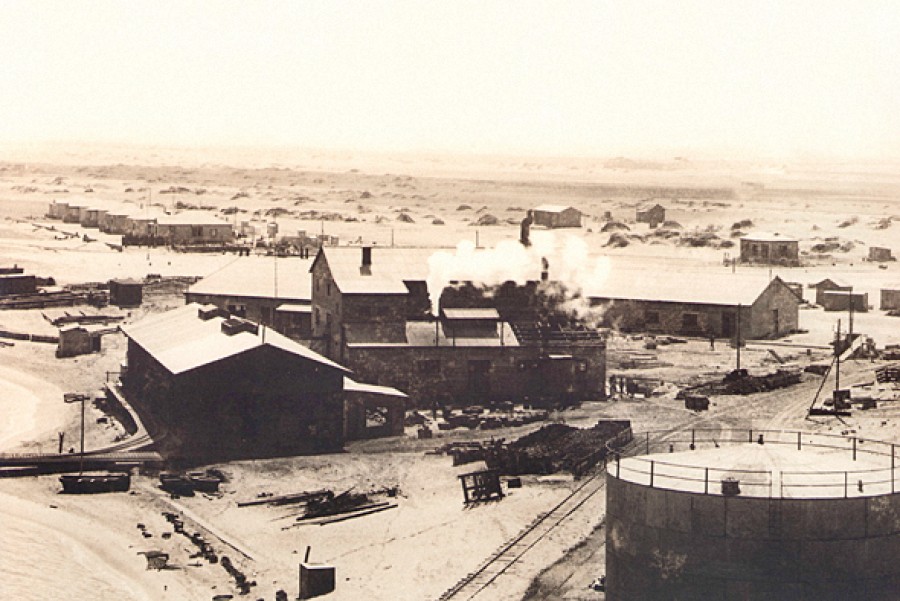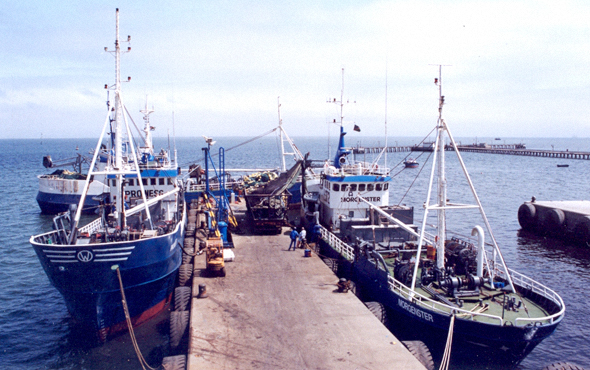Pioneering Namibia's Fishing Industry
 Walvis Bay
Walvis Bay – Etosha Fishing Corporation (Pty) Ltd was formerly the Walvis Bay Canning Company which pioneered Namibia’s fishing industry in 1943.
But the roots of Etosha Fishing go right back to the start of the century – to the arrival at the Cape of one of the first famous fishing entrepreneurs and to the fortuitous shipwreck of an early passenger liner. In 1900 John Ovenstone arrived at the Cape with his teenage son, Robert, leaving behind him a fish curing and smoking business in Glasgow, Scotland and the rest of his family.
Fishing was in his blood and it was to the sea that Ovenstone turned. His first problem was to acquire a boat. They simply were not to be had at prices he could afford. Then in May 1901 the Tantallon Castle was wrecked off Robben Island and he was able to buy one of her lifeboats. He put in a deck, rigged her out with sail and named her Scotia. She was the first of the Ovenstone vessels and equipped with herring nets he and his son, Robert, put her to work.
In 1902, when the rest of the family came out, father and son had extended their interests to sealing. In 1904 they started rock lobster catching and canning business, making their own cans.
In 1916 John Ovenstone Ltd was formed with Robert the first chairman. Two years later the Ovenstones built a rock lobster factory at Port Nolloth. In 1922 the family interest was extended to other canning ventures and in 1938 two Dutch built coasters were brought to ply between Cape Town and Port Nolloth.
In 1943 Walvis Bay Canning Company was established and this important event marked the beginning of the fishing industry in Namibia. In October 1949 Walvis Bay Canning Company commissioned Namibia’s first fish meal and canning plant. In doing so they pioneered the country’s pelagic fishing industry, being more than two years ahead of anyone else.
With the factory soon in full production, April 1953 saw Ovenstone South West Investments Limited going public with its registered address in Walvis Bay. It was the second Ovenstone public company and by the mid-1950s the family had launched 15 business ventures, had 1400 employees and owned or used 50 vessels.
The Namibian operation continued to prosper. As the leader in its field it succeeded in developing a new method of preserving freshly caught pilchards. By using Refrigerated Sea Water (RSW) – a breakthrough by the Walvis Bay Canning Company – the utilisation of pilchards for human consumption was dramatically increased.
When the pilchard resource collapsed in the late 70’s the Namibian fishing industry agreed that there should only be three canneries in operation. On recommendation of the country’s administration Walvis Bay Canning Company closed its cannery and went into a canning operation with General Development Corporation (Gendev).
In 1980, at the request of the administration, the fish meal plant was closed with this quota being processed by the Ohlthaver & List-owned company, Consortium Visserye.
With fishing in Namibian waters substantially reduced the Walvis Bay company was able to assist local fishermen by redeploying much of its fleet on other areas. In 1987 management and control was moved from South Africa to Namibia and the name changed to Etosha Fishing Corporation with the head office located in Swakopmund.

With the recovery of the pilchard resource the following year, Etosha Fishing re-established the fish meal plant at a cost of some N$12 million.
 Walvis Bay – Etosha Fishing Corporation (Pty) Ltd was formerly the Walvis Bay Canning Company which pioneered Namibia’s fishing industry in 1943.
Walvis Bay – Etosha Fishing Corporation (Pty) Ltd was formerly the Walvis Bay Canning Company which pioneered Namibia’s fishing industry in 1943. 